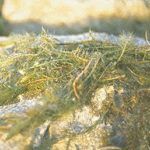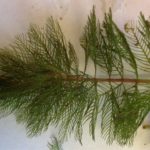Myriophyllum spicatum
Non-Native
USDA, NRCS. 2018. The PLANTS Database (http://plants.usda.gov, 28 March 2018). National Plant Data Team, Greensboro, NC 27401-4901 USA.
Illustration courtesy of University of Florida/IFAS Center for Aquatic and Invasive Plants. Used with permission.
What is Eurasian Watermilfoil?
Physical Characteristics
Leaves:
- Whorls of 3 to 5
- Mostly about 0.05-0.09 inches apart on stem
- Rarely reach 0.59 inches long
- All but lower bracts are shorter than flowers
Flowers:
Fruit:
- 4-lobed
- Almost spherical
Stem:
- Horizontal stem
- Branching leafy shoots about 8.1 feet long
- Reddish-brown in color
Roots:
- Branch from horizontal stem
Where Does it Grow?
EDDMapS. 2024. Early Detection & Distribution Mapping System. The University of Georgia – Center for Invasive Species and Ecosystem Health. Available online at http://www.eddmaps.org/; last accessed January 17, 2024.
Non-Native
Eurasian watermilfoil is a perennial plant native to Europe, Asia, and Africa and was probably brought to the U.S. as an aquarium plant.
Eurasian watermilfoil can be found in lakes, ponds, and slow-moving streams.
Is it Invasive?
Today, it is considered one of the most aggressive and problematic plants in the U.S. because of the dense colonies which it forms. Eurasian watermilfoil is non-native to North America and should not be spread.
This is a non-native plant that should not be grown as it is invasive and illegal to possess or transport this species in Texas. Please report sightings to the Texas Parks and Wildlife Department at (512) 389-4800.









